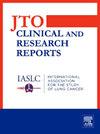来自IMscin002的主要结果:一项评估患者偏好和卫生保健专业人员对Atezolizumab皮下与静脉治疗非小细胞肺癌的看法的研究
IF 3.5
Q2 ONCOLOGY
引用次数: 0
摘要
皮下(SC) atezolizumab是一种含有atezolizumab和重组人透明质酸酶PH20的联合制剂,已被批准在50多个国家用于与静脉(IV) atezolizumab相同的适应症。IMscin002 (NCT05171777)是一项2期随机、开放标签、交叉试验,调查了患者偏好和卫生保健专业人员(HCPs)对atezolizumab SC与IV治疗NSCLC的看法;我们报告了IMscin002的主要结果。方法程序性死亡配体1阳性的切除NSCLC患者完成辅助化疗后无复发迹象,以及未接受化疗的程序性死亡配体1高转移性NSCLC患者按1:1随机分为A组(atezolizumab SC然后atezolizumab IV)或B组(atezolizumab IV然后atezolizumab SC)。在第3周期后,患者切换给药途径。第6周期后,患者选择延续期给药途径。主要终点是患者对SC或IV atezolizumab的偏好,次要终点是患者和hcp报告的结果和安全性。结果本研究共纳入179例患者。大多数患者(70.7%;123人中有87人(n = 87 / 107)更喜欢SC atezolizumab而不是IV,其中79.4% (n = 85 / 107)在延续期间选择SC atezolizumab。在HCPs中,75.2% (n = 76 / 101)表示atezolizumab SC比静脉注射更方便,77.8% (n = 77 / 99)强烈同意或同意atezolizumab SC将使患者在护理单位花费更少的时间。没有发现新的或意外的安全性发现,并且在给药途径之间的切换是可以容忍和管理的。结论大多数患者更喜欢SC atezolizumab而不是IV。没有新的安全性发现,并且在给药途径之间切换耐受良好。这些结果支持首选SC制剂以减轻治疗负担。本文章由计算机程序翻译,如有差异,请以英文原文为准。
Primary Results from IMscin002: A Study to Evaluate Patient Preferences and Perceptions of Health Care Professionals for Atezolizumab Subcutaneous Versus Intravenous for the Treatment of NSCLC
Introduction
Subcutaneous (SC) atezolizumab, a co-formulation containing atezolizumab and recombinant human hyaluronidase PH20), has been approved for use in more than 50 countries for the same indications as intravenous (IV) atezolizumab. IMscin002 (NCT05171777), a phase 2, randomized, open-label, crossover trial, investigated patient preferences and health care professionals’ (HCPs’) perceptions of atezolizumab SC versus IV for the treatment of NSCLC; we report the primary results of IMscin002.
Methods
Patients with programmed death-ligand 1-positive resected NSCLC who had completed adjuvant chemotherapy without evidence of recurrence, and chemotherapy-naive patients with programmed death-ligand 1–high metastatic NSCLC were randomized 1:1 to arm A (atezolizumab SC then atezolizumab IV) or arm B (atezolizumab IV then atezolizumab SC). After cycle 3, patients switched administration routes. After cycle 6, the patients chose the route of administration for the continuation period. The primary end point was patient preference for SC or IV atezolizumab, and the secondary end points were patient- and HCP-reported outcomes and safety.
Results
A total of 179 patients were included in this study. Most patients (70.7%; n = 87 of 123) preferred SC atezolizumab over IV, with 79.4% (n = 85 of 107) choosing SC atezolizumab during the continuation period. Among the HCPs, 75.2% (n = 76 of 101) indicated that atezolizumab SC was more convenient than IV, and 77.8% (n = 77 of 99) strongly agreed or agreed that it would allow patients to spend less time in care units. No new or unexpected safety findings were identified, and switching between administration routes was well tolerated and managed.
Conclusions
Most patients preferred SC atezolizumab over IV. There were no new safety findings, and switching between the administration routes was well tolerated. These results support the preference for SC formulations to reduce the treatment burden.
求助全文
通过发布文献求助,成功后即可免费获取论文全文。
去求助
来源期刊

JTO Clinical and Research Reports
Medicine-Oncology
CiteScore
4.20
自引率
0.00%
发文量
145
审稿时长
19 weeks
 求助内容:
求助内容: 应助结果提醒方式:
应助结果提醒方式:


